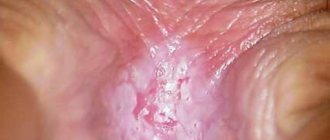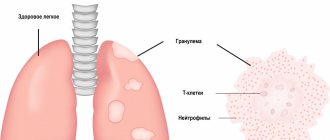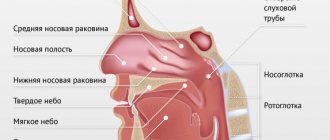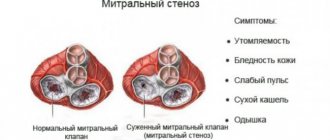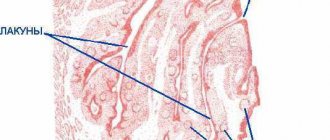Goiter of the thyroid gland is not quite the correct name; doctors use either the term goiter or enlargement of the thyroid gland. A goiter in humans is not at all the normal anatomical formation in the esophagus that all birds have; a goiter is a pathology of the thyroid gland.
- What is a goiter?
- Causes of goiter
- Classification of thyroid diseases
- Diagnosis of thyroid goiter
- The first signs and symptoms of thyroid goiter
- Treatment methods
- Complications
- Goiter prevention
What is a goiter?
In medicine, goiter refers to all benign neoplasms in the thyroid gland, both detectable by touch and already visible. A goiter is a knot in the thickness of unchanged tissue or an increase in the entire volume of the gland. With nodules it will be nodular or multinodular , and simply an increase - diffuse and a mixture of them in the form of a diffuse-nodular goiter .
On average, a diffuse version of goiter is found in every third person, but in different regions of Russia, benign lesions of the gland of various types - nodes or enlargement are found in 5% - 70% of residents, and the vast majority are women. It is not known why women are more susceptible to the disease; a direct connection between the level of production of thyroid hormones and the activity of the reproductive organs has been identified, and the leading cause of goiter is also explainable.
Treatment of thyroiditis
Mild subacute thyroiditis goes away on its own within 2-6 months. The fundamental principle of treatment is symptomatic therapy - that is, the elimination of external manifestations that cause discomfort to the patient. The drugs of choice are glucocorticoids and non-steroidal anti-inflammatory drugs. In the case of transient hypothyroidism and subacute thyroiditis, HRT is indicated.
The attending physician is faced with the task of reducing pain, relieving symptoms, as well as preventing possible relapses of the disease.
Causes of goiter
Due to the disease, goiter can be sporadic and endemic, and in this classification they focus not on the individual development of the pathology, but on the state of goiter morbidity in the region as a whole. The pathology is endemic in areas where goiter of any size and shape is found in every twentieth child and every third adult.
The most common causative factor in the development of pathology is iodine deficiency, which leads to a decrease in the production of iodolipols by thyroid cells, for which the production of glandular tissue growth stimulants increases compensatoryly. The enlarged glandular tissue is actually a goiter, which over time undergoes involution with the formation of nodules.
The formation of goiter is helped by a defect in the synthesis of thyroid hormones or perverted sensitivity of cells to them, taking certain medications that promote goiter growth and are called “goitrogens”. Goitrogens or thyreostatics are used to treat thyrotoxicosis. Pathology can be caused by some components of food; all of them have the ability to block the production of thyroid hormones; it is believed that soy flavonoids and thiocyanates contained in a variety of cabbages, corn and tobacco leaves have a particularly active effect on glandular tissue.
Hereditary predisposition is also important for the development of the pathological process, but specific genes have not yet been identified.
Book a consultation 24 hours a day
+7+7+78
Autoimmune Hashimoto's thyroiditis
It develops if a person has a congenital predisposition to pathologies of the immune system at the gene level. Hashimoto's thyroiditis is characterized by mutations that affect antibody production. The immune system begins to perceive thyroid cells as foreign and dangerous to the body. It produces special proteins - antibodies, which act on the thyroid gland and disrupt its functioning. This form of pathology has a protracted, chronic course and can be a lifelong condition.
Causes of chronic autoimmune thyroiditis:
- Excess iodine in the body (mainly due to diet).
- Herpes.
- Deficiency of vitamins and minerals, primarily selenium.
If we are not talking about diffuse goiter, when the entire organ is enlarged, then classification by localization is applied:
- Unilateral – neoplasms on one side.
- Double-sided - on both sides.
In women, Hashimoto's thyroiditis is up to 10-20 times more common. The average age of patients is from 40 to 50 years, but younger people are increasingly becoming ill.
Symptoms of Hashimoto's chronic thyroiditis appear due to decreased activity of the organ (hypothyroidism). Among the main ones:
- Loss of energy, constant drowsiness.
- Unreasonable weight gain.
- Bad mood.
- Coldness of the body.
- Hair loss, even baldness.
- Stool disorders.
- Growth of the gland in size, but without pain.
- An increase in the interval between menstruation, up to their cessation, is a characteristic symptom of chronic thyroiditis of the thyroid gland in women.
Help to make a diagnosis:
- Laboratory tests - a symptom of Hashimoto's thyroiditis is an increase in the level of T3 and T4 when inflammation has just begun, and later their production decreases, but the amount of TSH in the blood increases.
- The appearance in the blood of specific antibodies to thyroid cells.
- Ultrasound.
- Scintigraphy (if necessary, as an additional examination).
Treatment of a chronic inflammatory process of the autoimmune type is aimed at normalizing the functioning of the gland and treating hypothyroidism. Hormonal therapy is used for this. The dosage is individual in each case. Proper selection of medications restores the normal quality of life of patients or significantly slows down the rate of progression of the disease.
Classification of thyroid diseases
All processes in glandular tissue are divided:
- inflammatory - thyroiditis;
- autoimmune thyroiditis too;
- benign, including those filled with secretions - colloidal or nodules of glandular cells - adenomatous;
- malignant - cancer of various cellular variants, the most favorable are papillary and follicular, aggressive - medullary, as well as poorly differentiated and its “extreme” type - anaplastic.
According to the dysfunction, and the thyroid gland has one function - the production of hormones, goiter variants are distinguished:
- non-toxic, which is also referred to in the literature as euthyroid, when the production of thyroid hormones does not change;
- toxic occurs in two clinical variants: thyrotoxic occurs with hyperfunction of the thyroid gland and the pathological condition caused by this is called thyrotoxicosis;
- a decrease in endocrine production is characteristic of myxedema, and the condition caused by a lack of thyroid hormones is called hypothyroidism.
To determine the tactics for managing a patient with thyroid pathology, the Bethesda cytological classification is used with six categories, from “category 1” meaning uninformative analysis, benign formation - 2, through atypia and neoplasia, suspicion of cancer and cancer itself - starting from “3” categories".
Classification of thyroiditis
The classification of thyroiditis according to the International Classification of Diseases, 10th revision, distinguishes the following types of pathology:
- acute thyroiditis - an infectious lesion of the thyroid tissue: can lead to the formation of abscesses (purulent thyroiditis);
- subacute thyroiditis - De Quervain's thyroiditis (giant cell or granulomatous thyroiditis);
- chronic autoimmune thyroiditis - Hashimoto's disease or goiter (chronic lymphocytic thyroiditis or lymphoid goiter);
- Riedel's chronic thyroiditis or Riedel's goiter.
Thyroiditis induced by drugs or radiation does not have significant clinical significance, since this pathology is self-limiting and usually does not require serious measures.
Gestational or postpartum thyroiditis occurs during or after pregnancy due to changes in the immune system. It does not require serious treatment and usually goes away on its own.
Diagnosis of thyroid goiter
Based on the size of the enlarged thyroid gland, goiter is divided into three degrees:
- zero - normal size, when each of the two lobes is no larger than the nail phalanx of the patient’s thumb;
- the first provides two options - the node does not change the size of the lobe or there is a diffuse increase to the touch, but visually imperceptible;
- second, the gland is visible to the naked eye.
In most cases, nodes are found by chance, by palpation or during ultrasound of the neck for another clinical reason. A one-centimeter node can already be felt. The leading method for diagnosing organ pathology is ultrasound .
CT is used when the gland is very large and to detect a lobe hidden behind the sternum, which can cause complaints of pressure and breathing problems. People with very short necks may develop a substernal goiter. MRI today is not considered a competitor to ultrasound and CT and is considered less informative.
To identify functional capabilities, all patients with pathology undergo a blood test for the content of gland hormones and the stimulator of their production - pituitary thyroid-stimulating hormone or TSH. Blood calcitonin must be determined , which increases significantly in medullary cancer. If the calcitonin level is from 60 to 100 pg per milliliter of blood, then stimulation with calcium gluconate will help determine the diagnosis.
The next mandatory stage of diagnosis is fine- needle aspiration biopsy or FNA, which allows one to fairly accurately determine the nature of the process. In fact, this is a puncture of a pathological focus with a gradation of findings during microscopy according to Bethesda categories.
A biopsy is not always done, but for nodes larger than 1 centimeter it is required:
- for young people - under 20 years of age;
- with signs of a malignant process according to ultrasound data in the nodal formation itself or in the cervical lymph nodes;
- with a high concentration of calcitonin, characteristic of medullary carcinoma;
- with a family history of thyroid cancer;
- long-standing irradiation of the neck due to some other disease;
- The immobility of one vocal cord and the glow of the node on PET, performed for another clinical reason, are alarming for malignancy.
Isotope examination of the thyroid gland is not always carried out; scanning is necessary and useful:
- with its hyperfunction;
- the location of glandular tissue not only in the gland, but also in other organs - ectopic tissue.
Stages of the disease
Depending on the degree of manifestation of the main clinical symptoms, five stages of enlargement are diagnosed. In the first two stages of the disease, the size of the thyroid gland remains within normal limits and cannot be palpated during tactile examination. When swallowing, only the isthmus is visible. There are no visible visual changes on the neck.
Starting from the third stage of the disease, upon palpation, as well as upon swallowing, the lobes of the organ are noticeable and easily palpable.
The clinical picture of the disease is most clearly manifested in the fourth and fifth stages. Upon visual examination of patients, a change in the contours of the neck is noticeable, which is due to a significant growth and change in the structure of the thyroid tissue. During a tactile examination of patients, the doctor diagnoses a significant enlargement of the organ.
The main symptoms are accompanied by difficulty breathing, since as a result of structural changes in tissue, the trachea and esophagus are affected. Patients experience loss or change in voice timbre.
The clinical picture of the disease is complemented by increased sweating, irritability, sudden changes in emotional state, weakness, drowsiness, heart rhythm disturbances, pressure changes, hormonal dysfunction, muscle weakness and changes in total body weight.
Goiter is diagnosed taking into account all complex symptoms, starting from the third stage of the disease.
The consequences of this pathology are often unpredictable and in most cases, an increase in the size of the gland is a secondary symptom of the underlying disease. Sometimes pathological processes in an organ can occur latently, without manifesting a pronounced clinical picture. Symptoms of the disease may not be very pronounced, but the disease is chronic and in an advanced stage. Unfortunately, treatment with medications for this course of the disease is not effective.
The first signs and symptoms of thyroid goiter
The vast majority of patients do not have any symptoms if hormone production is normal. Enlargement of the lower third of the neck is possible with diffuse or multinodular goiter; individual nodules up to a centimeter do not change the configuration of the neck.
Compression of the trachea is possible if the trachea is very large or if the main mass of glandular tissue is located behind the sternum, as well as an increase in the diameter of the cervical vessels and a change in voice to the point of hoarseness.
Inadequate production of hormones does not correlate with the size of the gland and nodes; the symptoms of thyrotoxicosis or hypothyroidism are not obvious and nonspecific, but are manifested by impaired functioning of target organs: the cardiovascular system, nervous, subcutaneous fat, skin and muscles.
Initially, the patient complains of palpitations, nervousness, difficulty sleeping and concentration, weight loss or gain. A cardiac examination that does not detect cardiac pathology is performed, and only a blood test reveals abnormal hormone levels.
Very rarely, the classic thyrotoxic triad occurs: palpitations with trembling and exophthalmos - bulging eyes. An elderly patient may be hospitalized with thrombosis and heart rhythm disturbances with a visually undetectable pathology, but releasing too many hormones.
It is very rare that an adenoma develops that produces excess thyroid hormones; almost 80% of thyrotoxicosis is caused by a diffuse increase.
Prognosis for thyroiditis
The prognosis for thyroiditis depends on the severity of the pathology, the accuracy of diagnosis and timely treatment. Advanced cases, with goiter of large and enormous sizes, are now practically never encountered due to the availability of diagnostic and treatment methods. Most patients with acute, subacute and autoimmune thyroiditis (Hashimoto's disease) have a favorable prognosis.
With Riedel's thyroiditis, the prognosis depends on the success of treatment and the presence of damage to other organs. Deaths in patients receiving treatment are extremely rare.
Treatment methods
Treatment is required only for goiter symptoms. Thus, thyrotoxicosis with a diffuse increase is treated with goitrogenic drugs that suppress the synthesis of hormones, or the producing adenoma is removed. Insufficient function, on the contrary, is compensated for by synthetic endocrine drugs.
Nodular goiter cannot be treated with any medications; removal of a benign neoplasm is necessary:
- if you suspect cancer;
- compression of surrounding structures by the mass of the gland;
- life-impairing cosmetic neck deformity;
- if it is impossible to use radioactive iodine in a patient with thyrotoxicosis.
In other cases, with a node less than a centimeter, the patient is monitored with annual blood tests and ultrasound. For “goitrogenic” risk factors, examinations are carried out every six months. The growth of a node between examinations is a reason for a biopsy.
The question of surgery is raised when cellular atypia is detected, since cancer can occur under its mask in 30% of cases. The cytological picture of “follicular neoplasia”, and even more so “suspicion of cancer”, is the basis for removal of the affected lobe - hemithyroidectomy.
Treatment with radioactive iodine is highly effective; in case of thyrotoxicosis, hormone production returns to normal within a month. Contraindicated only for pregnant and lactating women, unacceptable in case of decreased function.
Indications for radioiodine therapy:
- obligatory when the thyroid gland is “uncontrolled” by pituitary hormones - an autonomous function with hyperproduction;
- possible for nodes with contraindications to surgery.
If the patient is unable or unwilling to undergo surgery, and the benign nature of the process is absolutely proven, innovative alternative methods are possible:
- introduction of sclerosing substances into the node - alcohol, tetracycline and others;
- destruction of the node by laser, liquid nitrogen, electric current.
Hirudotherapy does not stand up to criticism; the folk method does not cure goiter. The thyroid gland is abundantly supplied with blood, leeches are promised abundant nutrition, but they are not able to change the pathological structure. Nodular goiter cannot be cured with any medications; the node can only be removed.
Chronic thyroiditis
Another name for this form of inflammation is Riedel's thyroiditis. This is the least studied type of disease.
Among its main causes, systemic immune malfunctions are suspected, which increase the activity of plasma cells. This causes the gland cells to die, leaving fibrous areas. The likelihood of getting the disease is higher in people with Graves' disease or endemic goiter (even in the past).
Symptoms of chronic thyroiditis of the thyroid gland will rarely be noticeable at the very beginning of the disease. Because of this, time is wasted when conservative therapy is effective. As the disease progresses, the patient experiences symptoms that resemble cancer. They are caused by the rapid growth of the organ:
- "Lump in the throat.
- Difficulty breathing, suffocation.
- Long cough, hoarseness in the voice.
There is no pain when pressing on the gland.
To diagnose Riedel's thyroiditis, the following are used:
- A blood test - which is characterized by the following indicators: there are anti-TPO antibodies, the TSH level is elevated in 30% of cases, and in the remaining 70% - hormonal levels are normal.
- Cytological examination of tissues from puncture. It helps to distinguish cancer from fibrous inflammation without malignancy of the tumor.
Examinations such as ultrasound diagnostics and even MRI are not very informative with Riedel's thyroiditis.
Therapy is aimed at preventing complications. If the tumor is too large and puts pressure on neighboring organs, it is partially (or completely) removed surgically. After surgery, hormone replacement therapy, drugs that suppress fibrosis in tissues, and drugs for autoimmune processes are carried out. At the initial stage, such conservative therapy often does not help - the tumor grows too quickly, so it is difficult to avoid surgery.
Complications
Surgical treatment helps to get rid of a nodular goiter suspicious for a malignant process, but is associated with complications, infrequent, but nevertheless unpleasant:
- damage to the laryngeal nerve with subsequent hoarseness,
- removal of the parathyroid gland responsible for calcium metabolism,
- relapse of goiter.
The frequency of complications is affected by the size of the enlarged gland; the larger, the more likely it is. However, the incidence of complications does not exceed one percent.
But the most common complication of surgery and radioactive iodine is insufficiency of endocrine function, that is, a decrease in the level of thyroid hormones below the critical level, which is compensated by lifelong use of hormonal drugs.
Acute thyroiditis
Develops against the background of infection by bacteria or viruses. Often a complication from ENT infections: sinusitis, tonsillitis and others. The causative agent of purulent inflammation can be any infectious bacterium, but mainly these are such common microorganisms as streptococci, Klebsiella, and enterobacteria.
Acute inflammation of a non-purulent nature can appear after bruises of the neck in the area of the thyroid gland following radiation therapy.
Symptoms of acute thyroiditis of the thyroid gland:
- Swelling of the neck.
- Increased temperature up to fever.
- Sore throat that gets worse when swallowing or moving your neck.
- Change in voice - hoarseness and wheezing appear due to compression of the vocal cords.
- A general weakened state, when fatigue appears even after minor physical exertion. Active movements are accompanied by rapid heartbeat and weakness.
- Tissue abscess in advanced form.
A characteristic feature of this type of thyroiditis is the rapid increase in the intensity of symptoms.
The following will help confirm the diagnosis:
- Tests - assessment of the amount of thyroid hormones (in acute cases, their production will be normal), ESR, leukocytes in the blood.
- Ultrasound of the thyroid gland is used as an additional examination in a number of cases.
- A puncture from the affected area is necessary if an abscess has developed or a course of antibiotics has not helped. The analysis will show the type of pathogens and their sensitivity to a particular group of antibiotics.
Acute inflammation is treated with antibiotics. If there is an abscess, the affected part must be removed surgically to avoid complications.
Goiter prevention
There is no region in Russia where the population does not experience iodine deficiency, so the consumption of iodized products, primarily salt, is very important for the health of the thyroid gland. In endemic areas, it is useful to take iodine preparations; for an adult, 120 mcg of iodine is needed daily, for pregnant and lactating women - 250 mcg.
Surgeries on the neck organs require extensive surgical experience and technical virtuosity; the surgeons and oncologists of our clinic have created all the conditions for high-quality care for our patients.
Book a consultation 24 hours a day
+7+7+78
Diagnostics
To diagnose diffuse nodular goiter, an initial examination by an endocrinologist is necessary. It allows you to identify signs of the disease through visual assessment and palpation. If there is a suspicion of diffuse nodular goiter, the doctor will prescribe additional tests to clarify the diagnosis:
- blood test - to check the concentration of thyroid hormones;
- stool and urine analysis;
- Ultrasound examination allows you to find out the cause of the nodular formation.
To exclude the possibility of developing cancer, a fine-needle aspiration biopsy is used. It is performed if the diameter of the nodular formation reaches a centimeter or more. Scintigraphy is also performed - radioisotope scanning, which makes it possible to study the autonomy of the functional thyroid gland. Computed tomography provides the doctor with information about the size of the organ, its contours and structure, and the features of regional lymph nodes. X-rays are needed to ensure that foreign objects do not enter the esophagus or sternum area.
Only after laboratory tests are carried out, the endocrinologist selects drug therapy for the patient, which can gradually reduce the manifestations of the disease.
Treatment
If diffuse nodular nontoxic goiter syndrome occurs without complications, the patient is prescribed hormonal therapy and radioactive iodine preparations. In some cases, surgical treatment is advisable. It is indicated for the development of neoplasia, pronounced external manifestations of goiter, difficulty swallowing and breathing associated with compression syndrome.
Therapy is aimed primarily at restoring the hormone-producing function of the thyroid gland. Treatment with radioactive iodine preparations for diffuse nodular goiter usually demonstrates good results. Radical removal of the organ through surgery and subsequent hormone replacement therapy are indicated only in the absence of results from the prescribed drug treatment.
The likelihood of malignancy of the process with diffuse nodular goiter is low. The prognosis is generally favorable. If changes in the structure of the thyroid gland were noticed at the early stage of diffuse nodular goiter and are not severe, the main role is given to conservative treatment. The doctor selects medications with iodine compounds that are actively absorbed by the human body. In most cases, this measure is sufficient to eliminate the negative symptoms of diffuse nodular goiter and gradually reduce the thyroid gland down to its normal size.
